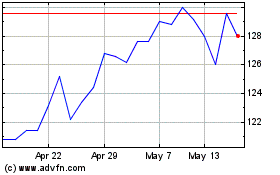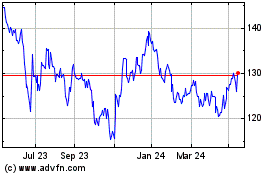Trade receivables, loans and other receivables that are
non-derivative financial assets and that have fixed or determinable
payments and are not quoted in an active market are classified as
'loans and other receivables'. Loans and other receivables are
measured at amortised cost using the effective interest method,
less any impairment. When calculating the effective interest rate,
the Group estimates cash flows considering all contractual terms of
the financial instruments, but does not consider future credit
losses. Financial assets with maturities less than 12 months are
included in current assets, financial assets with maturities
greater than 12 months after the balance sheet date are classified
as non-current assets.
Cash and Cash Equivalents
Cash and cash equivalents comprise cash on hand and demand
deposits and other short-term highly liquid investments with an
original maturity of three months or less that are readily
convertible to a known amount of cash and are subject to an
insignificant risk of changes in value.
13. Financial Instruments continued
13.1 Financial assets continued
Derivative Financial Instruments
Derivatives are recognised initially, and are subsequently
remeasured at fair value. Derivatives are classified as assets when
their fair value is positive or as liabilities when their fair
value is negative. Derivative assets and liabilities arising from
different transactions are offset only if the transactions are with
the same counterparty, a legal right of offset exists, and the
parties intend to settle the cash flows on a net basis. Fair value
movements on derivative financial instruments held for trading are
recognised in the Consolidated Statement of Comprehensive
Income.
The method of recognising fair value gains or losses depends on
whether derivatives are held for trading or are designated as
hedging instruments, and if the latter, the nature of the risks
being hedged.
Impairment of Financial Assets
Financial assets, other than those classified as at fair value
through profit or loss are assessed for indicators of impairment at
each balance sheet date. Financial assets are impaired where there
is objective evidence that, as a result of one or more events that
occurred after the initial recognition of the financial asset, the
estimated future cash flows of the investment have been adversely
impacted.
13.2 Financial liabilities
31 December 31 December
2014 2013
GBP'000s GBP'000s
===================================================== =========== ===========
Financial liabilities at amortised cost
Trade and other payables (excluding deferred income) 6,414 6,284
Bank loans 16,327 -
===================================================== =========== ===========
Total financial liabilities 22,741 6,284
===================================================== =========== ===========
Accounting Policy
Trade and other payables
Financial liabilities, other than those specifically accounted
for under a separate policy, are stated based on the amounts which
are considered to be payable in respect of goods or services
received up to the financial reporting date. The cost of other
liabilities is considered to approximate their fair value.
13.3 Financial risk and management objectives
The Group's objective in managing risk is the creation and
protection of shareholder value. Risk is inherent in the Group's
activities and is managed through a process of ongoing
identification, measurement and monitoring, subject to risk limits
and other controls. The process of risk management is critical to
the Group's continuing profitability. The Group is exposed to
market risk (which includes currency risk, interest rate risk and
inflation risk), credit risk and liquidity risk arising from the
financial instruments it holds. The Group's Investment Adviser is
responsible for identifying and controlling risks. The Board of
Directors supervises the Investment Adviser and is ultimately
responsible for the overall risk management of the Group.
The Group's risk management framework and approach is set out
within the Strategic Report (pages 34-38). The Board's
considerations of key risks impacting the business are set out
within the Strategic Report. The Board takes into account market,
credit and liquidity risks in forming the Group's risk management
strategy.
Market Risk
Market risk is the risk that the fair value or future cash flows
of financial instruments will fluctuate due to changes in market
variables such as changes in inflation, foreign exchange rates and
interest rates.
Inflation risk
The majority of the Group's cash flows from underlying
investments are linked to inflation indices. Changes in inflation
rates can have a positive or negative impact on the Group's cash
flows from investments. The long-term inflation assumptions applied
in the Group's valuation of investments at fair value through
profit or losses are disclosed in the fair value hierarchy section
13.4.
The Group's portfolio of investments has been developed in
anticipation of continued inflation at or above the levels used in
the Group's valuation assumptions. Where inflation is at levels
below the assumed levels, investment performance may be impaired.
The level of inflation linkage across the investments held by the
Group varies and is not consistent.
13. Financial Instruments continued
13.3 Financial risk and management objectives continued
Interest rate risk
Interest rate risk arises from the possibility that changes in
interest rates will affect future cash flows from underlying
investments therefore impacting the value of investments at fair
value through profit or loss. The Group has limited exposure to
interest rate risk as the underlying borrowings within the
unconsolidated investee entities are either hedged through interest
rate swap arrangements or are fixed rate loans. It is generally a
requirement under a PFI/PPP concession that any borrowings are
matched to the life of the concession. Hedging activities are
aligned with the period of the loan, which also mirrors the
concession period and are highly effective. The Group's corporate
facility is unhedged on the basis it is utilised as an investment
bridging facility and therefore drawn for a relatively short period
of time. Therefore, the Group is not significantly exposed to cash
flow risk due to changes in interest rates over its variable rate
borrowings.
Interest income on bank deposits held at underlying investment
level is included within the fair value of investments. Sensitivity
analysis showing the impact of variations in interest income
deposit rates on the fair value of investments is shown in section
13.5.
Foreign currency risk
The Group undertakes certain transactions denominated in foreign
currencies and therefore is exposed to exchange rate fluctuations.
Currency risk arises in financial instruments that are denominated
in a foreign currency other than the functional currency in which
they are measured. The carrying amounts of the Group's foreign
currency denominated monetary financial instruments at the
reporting date are set out in the table below:
31 December 31 December
2014 2013
GBP'000s GBP'000s
================================================= =========== ===========
Cash
Euro 2,263 1,367
Canadian Dollar 824 489
Australian Dollar 1 1
================================================= =========== ===========
3,088 1,857
Current receivables
Euro receivables 407 455
================================================= =========== ===========
407 455
Investments at fair value through profit or loss
Euro 210,962 187,104
Canadian Dollar 38,858 41,659
Australian Dollar 93,050 90,559
================================================= =========== ===========
342,870 319,322
================================================= =========== ===========
Total 346,365 321,634
================================================= =========== ===========
The Group uses forward foreign exchange contracts to mitigate
the risk of short-term volatility in foreign exchange on
significant investment returns from overseas investments.
Credit Risk
Credit risk refers to the risk that a counterparty will default
on its contractual obligations resulting in a financial loss to the
Group. The Group has adopted a policy of dealing only with
creditworthy counterparties at the underlying entity level. PFI/PPP
and similar concessions are entered into with government, quasi
government, other public or equivalent low risk bodies.
Liquidity Risk
International Public Par... (LSE:INPP)
Historical Stock Chart
From Jun 2024 to Jul 2024

International Public Par... (LSE:INPP)
Historical Stock Chart
From Jul 2023 to Jul 2024
